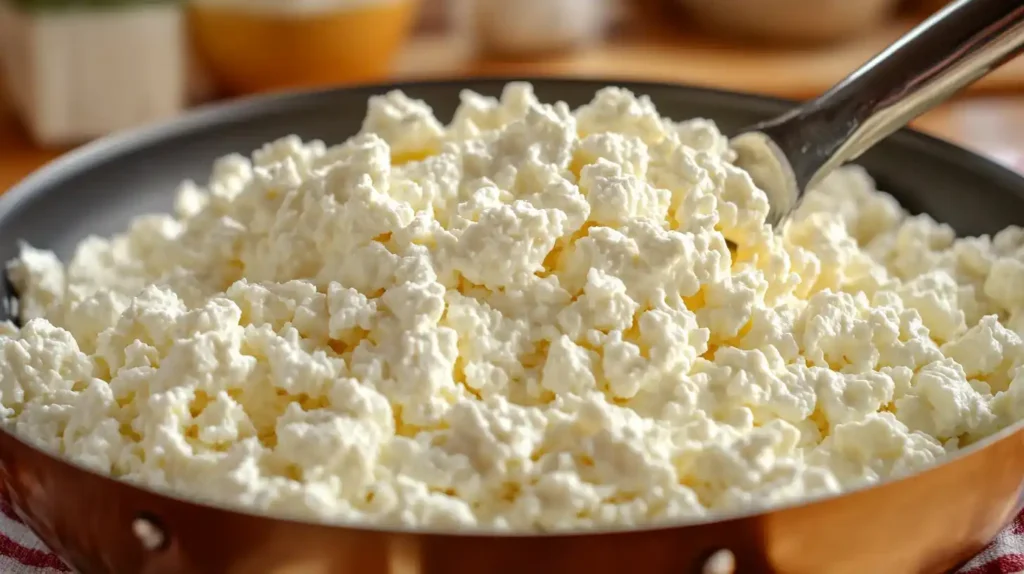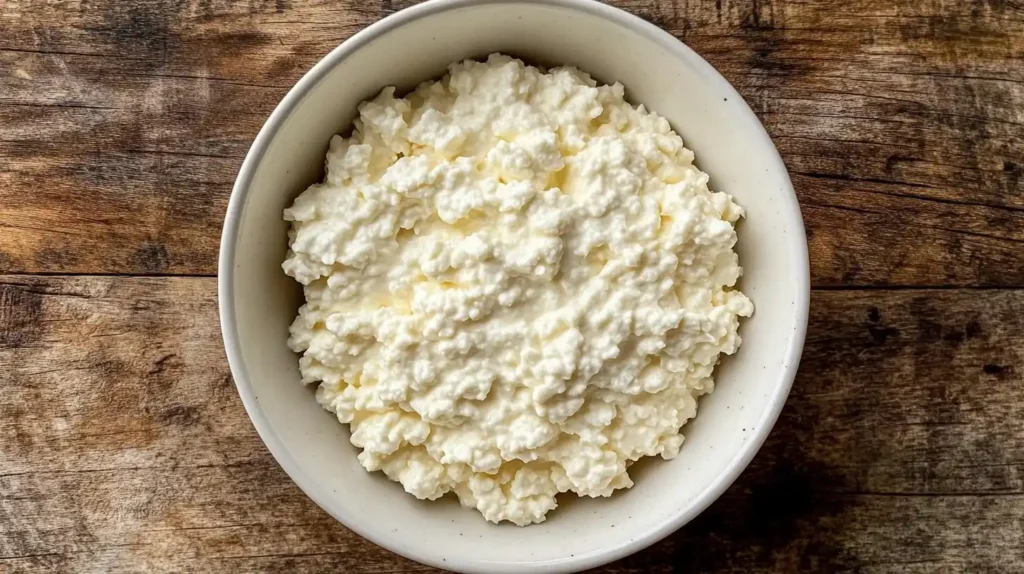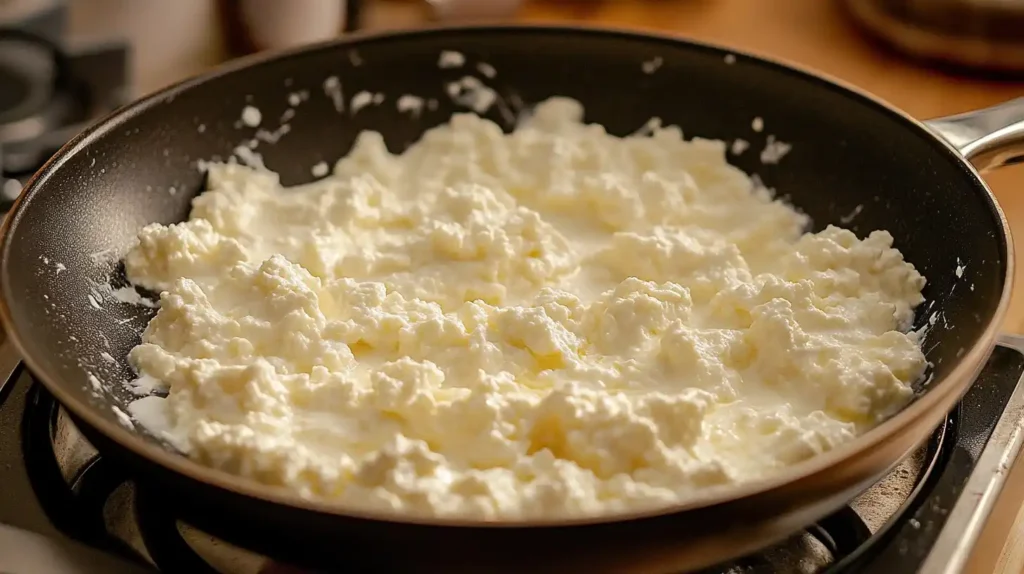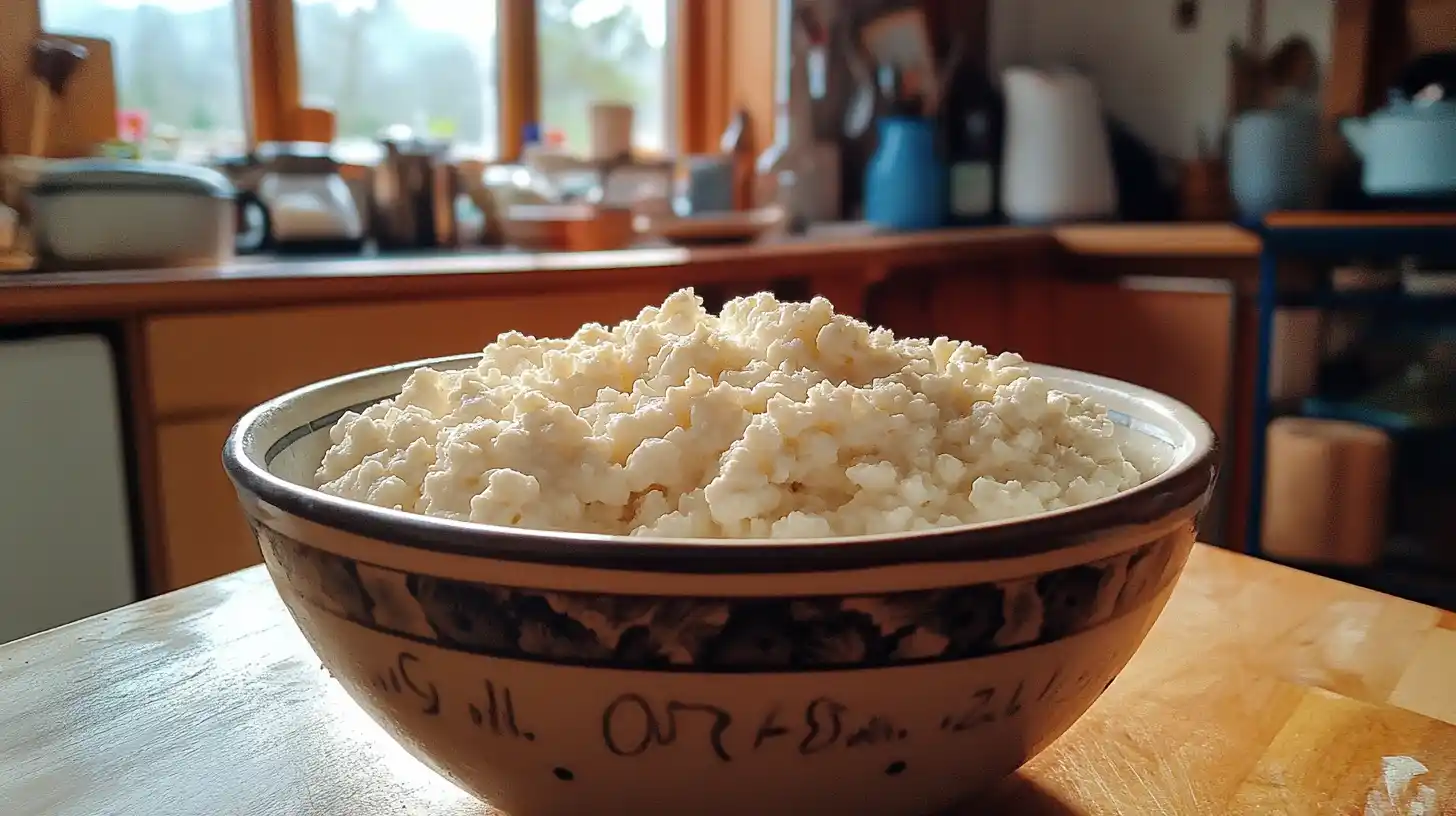Cottage cheese is a favorite among health-conscious people. But many ask, is it okay to cook cottage cheese? The answer is yes! It is a flexible ingredient that works well in many dishes. However, it does not melt like regular cheese. Instead, it softens and blends, adding a creamy texture.
This dairy product is rich in protein, calcium, and probiotics. That makes it a great choice for both savory and sweet meals. If you are curious about how to cook it, this guide will help. You will learn the best cooking methods, common mistakes to avoid, and tasty recipes.
Table of contents
- What is Cottage Cheese ?
- Nutritional Benefits of Cottage Cheese
- Does Cottage Cheese Melt?
- Best Ways to Cook Cottage Cheese
- Common Mistakes When Cooking Cottage Cheese
- 10. Not Experimenting with Different Recipes
- Is It Safe to Cook Cottage Cheese ?
- FAQ: Everything You Need to Know About Cooking Cottage Cheese
- Final Thoughts: Should You Cook Cottage Cheese ?
What is Cottage Cheese?
One of the most common questions is, “Is it okay to cook cottage cheese?” Unlike mozzarella or cheddar, cottage cheese does not melt into a stretchy, gooey consistency. Instead, it softens and blends into dishes, making it an excellent ingredient for creamy textures.
Nutritional Benefits of Cottage Cheese
One of the biggest reasons people love cottage cheese is its high nutritional value. It is loaded with protein, vitamins, and minerals that help keep your body strong.
Key Health Benefits:
- High in protein – Builds and repairs muscles.
- Rich in calcium – Strengthens bones and teeth.
- Low in fat – A healthy alternative to fatty cheeses.
- Packed with probiotics – Supports digestion and gut health.
- Low in calories – Ideal for weight management.
Does Cottage Cheese Melt?
Unlike cheddar or mozzarella, cottage cheese does not melt into a smooth, stretchy texture. Instead, when heated, it softens and blends into dishes.
Why Doesn’t It Melt?
- Low fat content – Not enough fat to create a gooey texture.
- High moisture – Holds too much water to melt properly.
- Curd structure – The protein structure keeps the curds firm.

Best Ways to Cook Cottage Cheese
Cooking cottage cheese is simple, and it enhances the texture and flavor of many dishes. Since it does not melt like other cheeses, it works best in recipes where creaminess and protein content matter more than stretchiness. Here are some of the top ways to cook with it:
1. Baking with Cottage Cheese
Using cottage cheese in baked goods can make them softer, richer, and more nutritious. It adds moisture and a light, fluffy texture to many recipes.
Pancakes and Waffles – Adding cottage cheese to pancake or waffle batter creates a high-protein, tender texture. It also keeps them moist.
Muffins and Breads – It replaces butter or yogurt, making baked goods lighter but still rich.
Cheesecake and Creamy Desserts – Cottage cheese can be blended and used instead of cream cheese for a healthier, lower-fat option.

2. Blending for Creamy Sauces & Soups
Another great way to answer “Is it okay to cook cottage cheese?” is by blending it into smooth sauces and soups. Since it does not melt, blending ensures a creamy, lump-free texture.
- Alfredo-Style Pasta Sauce – A lighter version of classic Alfredo.
- Creamy Soups – Adds thickness and protein to comfort dishes. Try this cream of jalapeño soup.
- Healthy Dips – Works as a high-protein base for spreads and dips.
3. Cooking with Eggs
Cottage cheese pairs well with eggs because it adds creaminess, protein, and a subtle tang.
- Scrambled Eggs – Stirring in cottage cheese makes them fluffy.
- Omelets & Frittatas – Helps create a creamy texture.
- Breakfast Bowls – A great topping for protein-packed breakfasts.
4. Using Cottage Cheese in Pasta Dishes
Many pasta recipes include ricotta, but cottage cheese is a healthier, high-protein substitute. It blends well into dishes, creating a creamy texture without the extra fat.
Lasagna – It works as a low-fat replacement for ricotta cheese. You can blend it for a smoother consistency.
Mac and Cheese – When mixed with cheddar, it adds creaminess and more protein.
Baked Ziti & Stuffed Shells – Perfect for Italian-style dishes that need a rich, cheesy base.
Common Mistakes When Cooking Cottage Cheese
Cooking cottage cheese is easy, but a few mistakes can affect the final dish. To get the best results, avoid these common errors and follow simple adjustments for better texture and taste.

1. Overheating Cottage Cheese
Mistake: Many people heat cottage cheese on high, expecting it to melt like cheddar. Instead, it curdles and turns grainy.
Solution: Use low to medium heat and stir gently. If a creamy texture is needed, mix it with milk or cream before heating. Adding it at the end of cooking can also help maintain smoothness.
Tip: Instead of direct heat, blend cottage cheese into sauces, soups, or pasta dishes so it warms gradually.
2. Choosing the Wrong Type of Cottage Cheese
Mistake: Using the wrong type affects texture and taste. Large-curd cottage cheese may not blend well into recipes, while some brands contain excess liquid.
Solution: For smooth sauces, dips, or baked dishes, use small-curd or blended cottage cheese. If a chunkier texture is preferred, large-curd works well in salads or scrambled eggs.
Tip: Some brands add extra whey to cottage cheese, making it watery. If needed, drain excess liquid before using it in cooking.
3. Not Draining Excess Liquid
Mistake: Some cottage cheese has too much whey, which can make dishes watery, especially in baked goods and pasta dishes.
Solution: Strain cottage cheese using a fine-mesh sieve or cheesecloth. Let it sit for a few minutes before adding it to a recipe.
Tip: Pressing gently with a spoon while draining can remove even more moisture, resulting in a thicker consistency.
4. Forgetting to Blend for a Smooth Texture
Mistake: Some recipes require a smooth, creamy consistency, but cottage cheese naturally has lumps. If not blended, the final dish may not turn out as expected.
Solution: Use a blender or food processor to puree cottage cheese before adding it to soups, sauces, or cheesecakes. This helps create a silky, uniform texture.
Tip: Adding a small amount of milk or yogurt while blending improves the smoothness and makes it easier to incorporate into recipes.
5. Expecting It to Melt Like Other Cheeses
Mistake: Many assume cottage cheese will melt into a gooey, stretchy texture like mozzarella or cheddar. However, it lacks the fat and proteins necessary to achieve this.
Solution: Instead of trying to melt it, use it as a creamy ingredient in mixed dishes. It works well when stirred into pasta sauces, blended into soups, or baked into lasagna or casseroles.
Tip: If a melty effect is needed, mix cottage cheese with shredded mozzarella or Parmesan for better results.
6. Using It as a 1:1 Substitute Without Adjustments
Mistake: Some people replace ricotta, cream cheese, or yogurt with cottage cheese without adjusting the recipe. This can lead to unexpected textures or flavors.
Solution: When substituting:
- For ricotta, blend cottage cheese to create a smoother texture.
- For cream cheese, mix it with Greek yogurt or sour cream to add richness.
- For yogurt, choose small-curd cottage cheese and blend it with milk if needed.
Tip: If using cottage cheese in baking, adjust liquid ingredients slightly to maintain the right consistency.
7. Adding It Too Early in Hot Dishes
Mistake: Adding cottage cheese too early in soups, stews, or pasta sauces can cause it to curdle or break apart.
Solution: Add cottage cheese at the end of cooking or after removing the dish from heat. This prevents unwanted texture changes.
Tip: Stirring it into warm dishes just before serving helps maintain its creamy consistency.
8. Ignoring Its Flavor in Savory and Sweet Dishes
Mistake: Cottage cheese has a mildly tangy flavor, which may not always match the dish if not balanced with other ingredients.
Solution: Adjust the taste by mixing in herbs, spices, or sweeteners.
- For savory dishes, add garlic, black pepper, paprika, or fresh herbs.
- For sweet dishes, mix with honey, cinnamon, or vanilla extract.
Tip: Taste and adjust seasonings as needed to ensure the best balance of flavors.
9. Using Low-Fat Cottage Cheese in the Wrong Recipes
Mistake: Low-fat cottage cheese lacks creaminess, which can make dishes dry or bland if used incorrectly.
Solution: If a creamy texture is needed, use full-fat cottage cheese or mix low-fat cottage cheese with a little cream or milk.
Tip: In baking or pasta sauces, full-fat cottage cheese provides a richer texture and better mouthfeel.
10. Not Experimenting with Different Recipes
Mistake: Many people only eat cottage cheese plain or in salads, missing out on its full potential.
Solution: Try using cottage cheese in:
- Smoothies and protein shakes – Blends well and adds protein.
- Breakfast bowls – Pairs well with honey, nuts, and fruits.
- Pasta and grain bowls – Works as a protein-rich topping.
- Casseroles and lasagna – Creates a creamy, cheesy texture.
Tip: If unsure where to start, replace ricotta or sour cream in a favorite recipe with cottage cheese.
Is It Safe to Cook Cottage Cheese?
Unlike aged cheeses, cottage cheese does not melt smoothly. Instead, when exposed to heat, it softens and blends into other ingredients. The curds may separate slightly, but the texture remains rich and creamy.
FAQ: Everything You Need to Know About Cooking Cottage Cheese
Cooking cottage cheese can be confusing if you’re not familiar with how it reacts to heat. Below are answers to the most common questions about using cottage cheese in different recipes.
1. Does cottage cheese curdle when heated?
Yes, cottage cheese can curdle if exposed to high heat too quickly. This happens because of its high protein and moisture content, which causes the curds to separate.
How to prevent curdling:
- Use low to medium heat when cooking.
- Blend cottage cheese before heating for a smoother texture.
- Mix it with other ingredients (like eggs or sauces) instead of heating it alone.
If you’re baking with cottage cheese, you don’t need to worry about curdling. The moisture from other ingredients helps maintain a soft texture.
2. Does cottage cheese melt like other cheeses?
No, cottage cheese does not melt like cheddar, mozzarella, or gouda. This is because it has a low fat content and high moisture level, preventing it from turning into a smooth, stretchy consistency.
Best ways to use it in cooking:
- Blend it into soups, sauces, and dips to create a creamy texture.
- Stir it into pasta dishes or casseroles, where it can blend with other ingredients.
- Bake it into dishes like lasagna for a soft and rich consistency.
Yes! Cottage cheese is a great substitute for ricotta, especially in lasagna, stuffed pasta, and baked goods. However, ricotta has a smoother texture, so adjustments may be needed.
How to substitute ricotta with cottage cheese:
- Blend cottage cheese until smooth for a closer match to ricotta’s texture.
- Strain excess liquid if using it in baking or pasta dishes.
- Mix it with a little Greek yogurt or sour cream for added richness.
If you want to try an easy recipe, these spaghettini pasta dishes are a great way to experiment.
4. Can you use cottage cheese in baked goods?
Absolutely! Cottage cheese adds moisture, protein, and a light texture to baked goods. It works well in:
- Brownies & cakes – Adds a creamy richness without making them dense.
- Pancakes & waffles – Boosts protein while keeping them fluffy.
- Muffins & quick breads – Creates a soft, tender texture.
5. How do you make cottage cheese smooth?
Because cottage cheese has a lumpy texture, some recipes require it to be smooth.
How to smooth cottage cheese:
- Blend it in a food processor or blender for 30-60 seconds.
- Strain it using a fine-mesh sieve or cheesecloth to remove excess liquid.
- Mix it with a little milk or yogurt for a creamier consistency.
Once blended, it works well in creamy soups, dips, and even cheesecakes.
6. How do you prevent cottage cheese from becoming watery?
Some brands of cottage cheese contain extra whey, which can make dishes watery.
Ways to remove excess liquid:
- Drain it using a fine sieve before adding it to recipes.
- Press it gently with a spoon to squeeze out moisture.
- Use dry-curd cottage cheese if available, which has less liquid.
This is especially important when using cottage cheese in lasagna or baking.
7. Can cottage cheese be used in soups and sauces?
Yes, but it works best blended into soups and sauces rather than left chunky.
How to use it in soups and sauces:
- Blend cottage cheese with a little milk to create a smooth, creamy base.
- Stir it into soups at the end of cooking to prevent curdling.
- Use it instead of cream or butter for a healthier, high-protein option.
8. Is cooked cottage cheese safe for babies?
Yes! Cottage cheese is a great source of protein, calcium, and healthy fats for babies. However, there are a few key points to remember:
Safety tips for babies:
- Use plain, unsalted cottage cheese to avoid excess sodium.
- Choose full-fat varieties for better nutrition.
- Serve it mashed or blended for a smoother texture.
For younger babies, mixing it with mashed fruit or vegetables can make it easier to eat.
9. Can cottage cheese be used in breakfast recipes?
Yes, cottage cheese is perfect for breakfast! It’s high in protein and calcium, making it a great way to start the day.
Ways to enjoy it for breakfast:
- Mix it with honey, berries, and nuts for a protein-packed bowl.
- Blend it into smoothies for added creaminess.
- Stir it into oatmeal or granola for extra texture.
- Use it in pancakes or waffles for a fluffy texture.
10. Can cottage cheese be frozen for later use?
Yes, but freezing cottage cheese changes its texture. The curds become crumbly and watery after thawing.
Best ways to freeze cottage cheese:
- Use full-fat varieties, as they freeze better than low-fat versions.
- Keep it in an airtight container to avoid freezer burn.
- Thaw slowly in the fridge and stir well before using.
Final Thoughts: Should You Cook Cottage Cheese?
So, is it okay to cook cottage cheese? Yes! While it doesn’t melt like cheddar, it blends well into baked goods, creamy sauces, and pasta dishes. It adds richness, protein, and a light texture to many meals.

